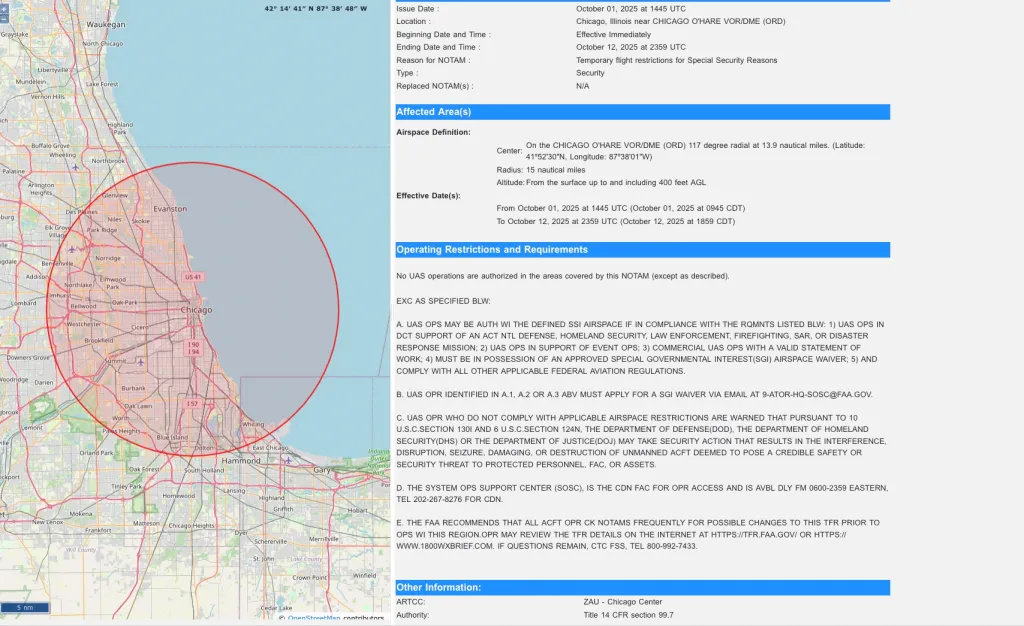With a large-scale ICE operation now underway in the Chicago area, the Federal Aviation Administration (FAA) has enacted a uniquely massive 15-mile radius prohibition against drone flights. The FAA told us the temporary flight restriction (TFR) for drones in this area was requested by the Department of Homeland Security (DHS). The no-fly zone lasts through Oct. 12.
Under this restriction, only drones operated in support of national defense, homeland security, law enforcement, search and rescue and other emergency response efforts, or commercially used drones with a valid statement of work are allowed to fly. In addition, media organizations can apply for an approved special governmental interest airspace waiver. Any drones violating this restriction can be seized or destroyed, the TFR explains. It also extends about 15 miles into Lake Michigan, without any explanation.

There have been no reports that drones have created major problems for federal agents. However, having uncrewed aerial vehicles flying during an ongoing operation like the one taking place in the Chicago area clearly raises concerns about operational security as well as the safety of helicopters and other aviation assets flying in support of it. Meanwhile, despite the possibility of waivers for commercial and journalistic purposes, the restriction is also drawing the ire of commercial drone operators and sparking worries about civil liberties violations.
The move comes as the Trump administration has followed through on its vow to bring federal forces into the nation’s third-largest city. Hundreds of federal agents have poured into the region. On Tuesday, President Donald Trump suggested responding to protests in Chicago and elsewhere would be a good way to prepare troops for combat.
“…we should use some of these dangerous cities as training grounds for our military – National Guard – but military, because we’re going into Chicago very soon,” Trump told a room full of admirals and generals gathered at Marine Base Quantico.
In response to these actions, hundreds of people have taken to the streets in downtown Chicago. They are protesting Immigration and Customs Enforcement (ICE) immigration arrests and Trump’s promised federal troop deployment. One hundred National Guard troops are being deployed to Illinois to protect federal facilities.

Early on Tuesday, about 300 agents from various federal organizations, “using drones, helicopters, trucks and dozens of vehicles, conducted a middle-of-the-night raid on a rundown apartment building on the South Side of Chicago, leaving the building mostly empty of residents by morning and neighbors stunned,” The New York Times reported. Sources said the raid targeted the Tren de Aragua cartel, which the Trump administration has declared a narco terrorist organization.
Federal officials say they have made nearly 1,000 arrests for immigration violations in what has been dubbed Operation Midway Blitz, according to the DHS.
In addition, many of the protests have been aimed at a federal facility in suburban Broadview, located about 10 miles west of Chicago. The facility is being used to detain hundreds of people arrested on immigration violations. At least five people have been arrested amid clashes between protesters and agents in which chemical agents have been deployed to disperse crowds.

Issuing TFRs for emerging security concerns is not uncommon. However, the area this one covers is unusually large. TFRs are more commonly much more focused geographically.
For instance, a previous TFR was imposed over the Broadview facility. There is also one that is active over the federal facility in Portland, Oregon, which is a hotpoint for protests, that is one mile in radius.
Last year, for example, dozens of drone no-fly zones were created in the New Jersey area following thousands of reported mystery drone sightings, most of which proved to be unfounded. However, unlike the Chicago-area TFR, those were imposed on a localized level, mostly over power infrastructure sites. The vast majority only covered a one-mile radius of airspace. The TFR imposed over the Picatinny Arsenal was an outlier with a three-mile radius, a fraction of the area covered by the Chicago restrictions.
Not surprisingly, the local drone industry, which relies on flying the skies of Chicago to conduct business, is not happy with the restriction.
“The airspace closure affects Chicago’s substantial commercial drone industry, including real estate photographers, construction inspectors, and infrastructure surveyors who rely on drones for daily operations,” wrote Haye Kesteloo, Editor in Chief of two drone tech publications: DroneXL.co and EVXL.co. “Part 107 commercial pilots cannot work in the restricted airspace, while recreational pilots face the same grounding through mid-October.”
The restriction “represents one of the most expansive non-emergency TFRs affecting civilian drone operations in a major U.S. city, comparable to airspace closures during major events like the Super Bowl but lasting significantly longer,” he added.
“There’s zero legitimate security reason for this TFR,” Charles Black, a Chicago resident who writes software, complained on X.
Despite the ability of news organizations to apply for a waiver to fly drones, there are also concerns that the TFR is infringing on the Constitutional right of people to observe the actions taking place on the ground.
“The Chicago TFR is the exact scenario First Amendment advocates warned about: government using airspace restrictions to prevent documentation of controversial operations in public spaces,” Kesteloo, who is also a drone journalist, told us. “Combined with the 5th Circuit’s ruling that drone operation isn’t expressive conduct, we’re seeing the emergence of a legal framework where federal agencies can effectively control visual journalism by controlling airspace.”
We have asked DHS, ICE and Customs and Border Protection (CBP) for more details about why they sought this large airspace closure and will update this story with any pertinent information provided.
Update: 10:43 PM Eastern:
CBP responded to our request for information, telling us that a “credible threat” that small drones might attack officers during the protest prompted them to ask for the TFR. You can read our story about that here.
Contact the author: [email protected]
